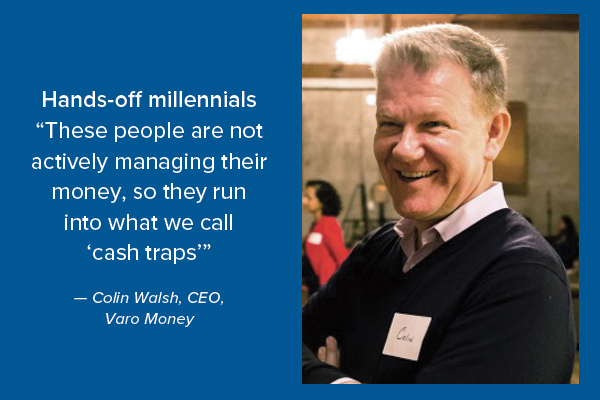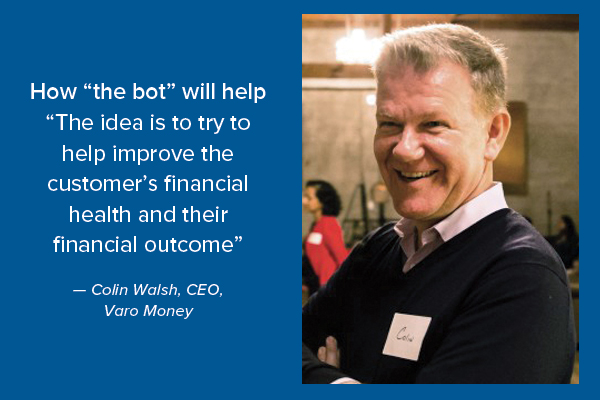Q&A: What Varo Money’s Colin Walsh has in mind
Part 1: Varo’s OCC application puts the fintech mobile banking app squarely on retail banks’ competitive radar—or should
- |
- Written by Bill Streeter
 First of a two-part series: Varo Money hopes to become "Varo Bank, N.A." Even before that, Varo brings a blend of fintech innovation and traditional banking backgound to retail financial services.
First of a two-part series: Varo Money hopes to become "Varo Bank, N.A." Even before that, Varo brings a blend of fintech innovation and traditional banking backgound to retail financial services.
There are three reasons Varo Money stands out from the crowded field of fintech apps that handle money management, payments, and lending.
One is that the venture was formed by people with banking experience.
A second reason is that Varo rolls several different functions—banking, payment, lending, and money management into one “holistic” mobile app, whereas most of the others do one thing, or perhaps two.
Third, and particularly significant for bankers, is that on July 25 the company announced it had applied to the Office of the Comptroller of the Currency (OCC) for a national bank charter, as well as to FDIC for deposit insurance. If granted, Varo Money would become Varo Bank, N.A.
Varo Money has three co-founders listed on its website: Colin Walsh, CEO; Roger Van Duinen, head of lending; and Mykola Klemenko, chief technology officer. Here is their banking experience in brief, drawn from their LinkedIn pages:
Walsh has worked in retail banking at American Express, Lloyds Banking Group, and Wells Fargo. Van Duinen worked at credit card bank Providian among other nonfinancial companies, and Klemenko worked at Lending Club, mobile banking software provider Clairmail, and Ukrainian bank JSB Energobank. Other key employees also have bank or fintech experience.
In 2016 the company raised $28 million in a Series A funding round led by Warburg Pincus. On its website the private equity firm describes its Varo Money investment as “a mobile-only banking start-up based in San Francisco, California. … Through its mobile app, Varo’s 24/7 digital financial coach delivers proactive insights and analysis of spending, as well as real-time budgeting. Varo will provide a debit card, savings and lending products, and will offer integrated access to other popular finance apps via an in-app marketplace.”
Just prior to the OCC announcement, we interviewed Colin Walsh at length about the new company. In this first of two installments, Walsh covers the following points:
• The concept behind Varo Money and how it came to be formed.
• Key elements of the app-based product: deposits, lending, money management, payments.
• Varo’s current primary market—“the hands-off millennials.”
• Details of its AI-driven “Cash Board,” an interactive money management solution, or “coach” as Warburg Pincus described it.
• Its no-fee revenue model.
What follows is an edited recounting of the interview.
Banking Exchange: There is no lack of fintech mobile app options. What prompted you to form Varo Money and what sets it apart?
Walsh: We started the company in late 2015, and then moving into 2016 raised a very large Series A round of funding, and brought together a full ecosystem of partners including on the deposit taking side The Bancorp Bank [Wilmington, Del.], Visa, and Galileo. On the lending side we became a state-licensed non-bank lender in 11 states.
We put together the whole infrastructure with the vision of creating the bank of the future. We would take deposits, facilitate payments, make loans—all with the intent of creating a much more holistic financial solutions that integrated those retail banking products along with tools to help customers fix the fundamentals of their financial health.
Throughout 2016 we also built a team of people from deep backgrounds in financial services as well as consumer technology to help redesign the banking experience so it would be loved by and helpful to consumers.
We entered into beta in early 2017 getting customers on board and “running water through the pipes”—making sure everything worked with the core direct deposit accounts, the debit card, with aggregation, with some insights around spend tracking and some early lending activity.
We very quickly hit the numbers we were looking for in terms of new customer acquisition as well as new customer engagement. And then we pushed into the Apple App Store on June 14 of this year.
The numbers are growing quickly every day. If you read the reviews on the app store they are very encouraging and we’re looking forward to rolling out a number of new features over the next several months. Right now Varo Money runs only on the iPhone. Next year we’ll introduce an Android App.
[As of early July, Walsh said Varo Money had “over 3,000 customers on the app.” In a follow-up query later in the month, a spokesperson responded: “We are not able to provide exact numbers, but it is significantly more than the 3,000.”]
Banking Exchange: What marketing have you done so far?
Walsh: Right now it’s low volume in terms of the money that we’re spending. We’re focusing on paid social—largely Facebook and Instagram. We’ve started doing a little bit of marketing in the Apple App Store. We’ve done some paid search, predominantly through Google. There are a number of other channels that we will start to deploy as we get ready to roll this out later this year on a broader scale.
Banking Exchange: Talk a little bit about the product set that’s part of Varo Money now.
Walsh: It’s a classic retail banking model but delivered through more modern technology. So it’s designed around the mobile experience first, but we have a call center, we have an IVR [interactive voice response] system, we have a website. The website is more brochureware today, but eventually it will be a more functional.
The application integrates checking, saving, lending but what makes it truly innovative is that it’s focused on providing holistic solutions that actually solve problems.
One of the major problems that we found with the segment that we’re targeting—what we call the “hands-off creditworthy millennials.” These are people aged 22-36 that don’t spend a lot of time on a day-to-day basis managing their money and doing detailed spreadsheets and spending analysis. About 70-75% of the people we spoke with over about a year and a half of research are hands off. [See “As 'PFM' fades, 'PFE' steps in”]
They just check their bank balance every few days and they have in their mind an idea of what their incomings and outgoings are going to be. Unfortunately it’s not always correct, because there is a great deal of expense volatility. It could be really good things like, “My best friend is getting married and I have to buy a plane ticket to Mexico.” Or bad things like a sudden medical expense or flat tire, or whatever.

As a result of that volatility and the fact that these people are not actively managing their money they run into what we call “cash traps.” Not enough cash in their checking account to pay their bills and they either have to borrow money or draw down their savings. They’re in this constant cycle of not building up savings and it’s frustrating for them because these are people who are ambitious and want to get ahead and they want to move up the wealth ladder.
The essence of the Varo design is to give people the tools they need to see their whole financial picture; to be able to track expenses and understand where their money is going in a very simplistic way.
And then also we’ve designed a “cash board” that’s going to be in the app in the next few weeks, where you can go in and the first thing you see is your combined checking account balances. In addition, we’re using machine learning algorithms to detect all the upcoming bills as well as when their next paycheck is coming. And so the app shows them what their expenses are going to be and when their next paycheck is and whether or not they’re going to have a positive balance or a negative balance.
And then from that information an AI bot [named “Val,” according to the Varo website] will make recommendations in terms of what the customer should do about their situation.
Banking Exchange: Can you give some examples of the recommendations?
Walsh: If their situation is positive it will encourage them to put more into savings. There’s nothing more important than to create that positive behavior as frequently as possible to help people build up the emergency savings buffer and then eventually to start going after bigger goals.
If they’re in a negative situation it will give them other recommendations. So the in-app message might be, “Bill, it looks like you’re heading for a bit of a cash crunch. We suggest that you slow down spending or you might want to move some money from a savings account just to make sure you cover your bills that are coming up.”
Banking Exchange: Are you using aggregation to get the balances not held in The Bancorp Bank?
Walsh: We are using aggregation but it’s not the core feature of Varo. I’m very familiar with the fundamentals of helping customers have the right to their data and at the same time making sure that the right security protocols and minimum standards are in place to protect customer data.
But some of the actions that the banks have taken to try and restrict access or create sort of bi-lateral agreements so they can take control of the data are fundamentally flawed because at the end of the day the consumer has to be able to choose what they want to do with their data provided that it’s protected and it’s secure.
Banking Exchange: In your focus groups with the millennials and others were they concerned about data security?
Walsh: It tends to rank the lowest in the things that they worry about. They want to trust that their data’s not being sold, and that their data is going to be kept secure. But it’s not their biggest worry. Their biggest worry is how to get financially from point A to point B and having a financial institution that’s going to actually help them get there.
Banking Exchange: Will you focus beyond millennials at a certain point?
Walsh: Yes. We chose to focus on millennials because they’re more digitally savvy—very high adoption of mobile banking apps or other types of financial apps and lower barriers to switching because they don’t have as much complexity in their financial situation. So we felt it was a natural point of entry. However, our doors are open to whoever wants to do business with us.
Banking Exchange: You’re licensed to lend in 11 states at present. What types of loans are you making?
Walsh: Right now we’ve got two loans.
One is what we call a flexible line of credit—an unsecured credit line from $1,000 to $5,000 depending on credit approval criteria. We’re only lending to prime borrowers at 660 and above.
It’s used as a form of short-term credit—an alternative to paying an overdraft fee, incurring late fees, or having to take a cash advance against a credit card. It’s really simple to use. You can set it up with a few taps on the mobile phone. If you are approved, it’s easy to move money back and forth between the flexible credit line and the bank account.
The bot will let you know what it feels is the best alternative for you at a particular time. It would always first attempt to either have you move money from another account or slow down your spending, but if it looks like you are a couple days away from having to pay your mortgage or your rent it might say you may be better off just drawing from your flexible credit as a way to help smooth out your cash flow.
The second product is our installment loans. And so these are three year, five year fixed-term installment loans. No fees up front.
The primary use case here is to consolidate high interest rate debt. Many customers have accumulated a lot of expensive credit card debt and so the first thing would be to try to consolidate that to lower their interest expense and their payments. But it could also be used for major purchases for education, moving expenses, a wedding, buying a used car, or whatever.
Banking Exchange: What are the rates you charge on these loans?
Walsh: The flexible line of credit varies from 12% on the low end to 24% on the high end. The installment loans range from 8.9% on the low end to also 24% on the high end. So we’re far from the payday loans that you see out there with 36% APRs. This is really much more trying to help provide customers with some tools to help manage their financial situation and ultimately get them out of debt and moving up the wealth ladder.

Banking Exchange: So will the bot proactively say to a customer who has taken out a flexible loan, “You need to really pay that down because you’re running up a lot of interest on that”?
Walsh: If it’s starting to compound, yes, absolutely. Because the idea is to try to help improve the customer’s financial health and their financial outcome. So whether it’s a loan from Varo or it’s a loan from somewhere else, if they’ve got the disposable cash to pay it down and that’s the best situation for them the bot would definitely recommend that to them. It does what is best for the customer.
Banking Exchange: A Visa debit card is part of the account. Can customers write checks against a Varo Money account?
Walsh: You can actually send a check through the app. There’s a section where you can pay a bill—send a check to somebody. You just have to set them up—a few taps and then it will go.
Banking Exchange: What about person-to-person (P-to-P) digital payments?
Walsh: Definitely on our road map—probably later this year. You can also do ACH payments, and we’re looking at several other payment vehicles to just improve the overall stickiness of the bank account.
Banking Exchange: What’s your revenue model?
Walsh: I’ll start with the fees we don’t charge. We don’t charge overdraft fees, minimum balance fees, foreign transaction fees. We’re part of the surcharge-free Allpoint ATM network of 55,000 ATM’s. If you were to go to a non-Allpoint ATM there’d be a $2.50 charge for that. So that’s really the only bank-related fee we charge.
We earn income off of interchange whenever anyone swipes our debit card.
And then on the lending obviously there’s the spread. So it’s really pretty traditional kind of retail bank P&L.
Part of why we’re able to not charge all those fees is we don’t have bricks and mortar distribution. We don’t have our own ATM network. We don’t have legacy technologies. So our unit economics are much more favorable because of the nature of our digital business model.
•
In part two of the interview with Colin Walsh, he speaks of how his experiences working at three large financial services companies helped him formulate his concept of “good revenues” and “bad revenues.”
He also discusses why the fintech movement is truly transformational and will ultimately prove very disruptive to traditional financial institutions.
Finally he explains why being a fully regulated national bank will not impede Varo’s ability to grow and innovate.
Tagged under Retail Banking, Technology, Channels, Fintech,













